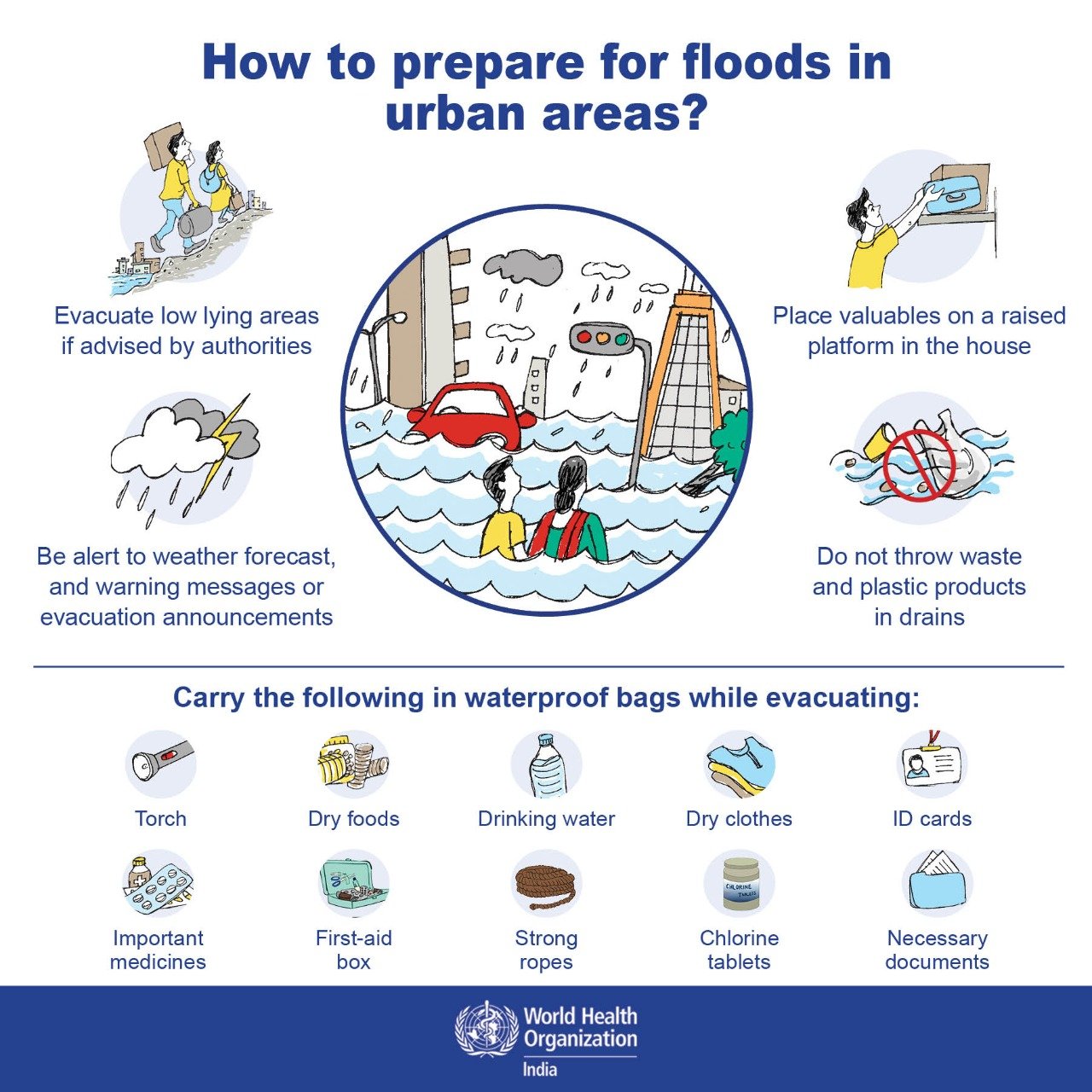Understanding Flood Alerts: Preparing For Flash Floods And Heavy Rainfall

Table of Contents
Recognizing Flood Warning Systems
Effective flood preparedness begins with understanding how flood warnings are issued and what they mean. Knowing the difference between alert levels is crucial for taking appropriate action.
Types of Flood Alerts
Different regions may use slightly varying terminology, but generally, you'll encounter these key alert levels:
- Flood Watch: Conditions are favorable for flooding. Stay informed, monitor weather reports, and be prepared to act if a warning is issued. This is the time to review your emergency plan and ensure your emergency kit is ready.
- Flood Warning: Flooding is occurring or is imminent. Take immediate action to protect yourself and your property. This often necessitates evacuation.
- Flood Advisory: Flooding is possible in specific areas. While less severe than a warning, it still requires attention and vigilance. Be aware of your surroundings and be prepared to take action if the situation worsens.
These alerts are disseminated through various channels, including:
- National Weather Service (NWS) website and mobile app
- NOAA Weather Radio
- Local news channels and websites
- Emergency alert systems on smartphones
Understanding Flood Risk in Your Area
Knowing your specific flood risk is paramount. Many areas have a history of flooding, making some locations more vulnerable than others.
- Check FEMA Flood Maps: The Federal Emergency Management Agency (FEMA) provides detailed flood maps that show areas with different levels of flood risk. Knowing if your home is located in a floodplain is essential.
- Contact Local Authorities: Your local emergency management agency or city hall can provide valuable information on your area's flood history and preparedness resources.
- Identify Potential Hazards: Walk around your neighborhood and identify potential flood hazards, such as low-lying areas, drainage issues, and areas prone to rapid water accumulation.
Preparing Your Home for Flash Floods and Heavy Rainfall
Proactive preparation significantly reduces the impact of a flood. A multi-pronged approach incorporating planning, property protection, and emergency supplies is crucial.
Developing an Emergency Plan
A comprehensive family emergency plan is vital, especially for households with children or elderly members.
- Establish Evacuation Routes: Plan multiple escape routes from your home, considering potential road closures due to flooding.
- Designate Meeting Points: Identify a safe meeting place inside and outside your home in case family members become separated during the emergency.
- Practice Your Plan: Regularly practice your evacuation plan to ensure everyone knows what to do in case of a flood.
Protecting Your Property
Taking steps to protect your property can mitigate damage during a flood.
- Move Valuables to Higher Ground: Relocate important documents, electronics, and other valuable items to upper floors or a safe, dry location.
- Seal Basement Windows: Waterproof your basement windows to prevent water ingress.
- Install Flood Barriers: Consider installing flood barriers at doorways or other vulnerable entry points.
- Purchase Flood Insurance: Flood insurance is often not included in standard homeowner's insurance policies. Consider purchasing this critical coverage to protect your financial investment.
Assembling an Emergency Kit
Having a well-stocked emergency kit is essential for survival in the aftermath of a flood.
- Water: Store at least one gallon of water per person per day for several days.
- Food: Include non-perishable, easy-to-prepare food items.
- First-Aid Supplies: Pack a comprehensive first-aid kit with bandages, antiseptic wipes, pain relievers, and any necessary medications.
- Important Documents: Store copies of important documents (insurance policies, identification) in a waterproof container.
- Flashlight and Radio: Include a battery-powered flashlight and a weather radio.
Regularly check and replenish your emergency kit to ensure its readiness.
Responding to a Flood Alert
Knowing how to react to a flood alert is just as crucial as preparation.
Evacuation Procedures
If a flood warning is issued, follow evacuation orders immediately.
- Leave Promptly: Do not delay; rapid-onset floods can be extremely dangerous.
- Use Designated Routes: Follow designated evacuation routes provided by authorities.
- Secure Your Home: Take necessary steps to protect your property before leaving, but prioritize your safety.
Staying Safe During a Flood
During a flood, safety should be your top priority.
- Avoid Floodwaters: Never attempt to drive or walk through floodwaters; the depth and current can be deceiving and extremely dangerous.
- Stay Away from Downed Power Lines: Report any downed power lines to authorities immediately.
- Seek Higher Ground: If you are caught in a flood, seek higher ground immediately.
- Be Aware of Contaminated Water: Floodwaters are often contaminated with sewage and other hazardous materials. Avoid contact if possible.
Conclusion
Understanding flood alerts is not merely about heeding warnings; it's about proactive preparedness. By developing an emergency plan, protecting your property, assembling an emergency kit, and understanding the various alert levels, you significantly reduce your vulnerability to flash floods and heavy rainfall. Don't wait for a flood warning! Take control of your safety by understanding flood alerts and implementing the preparedness measures outlined in this article. Check your local flood risk, create an emergency plan, and sign up for flood alerts today. Your safety depends on it.

Featured Posts
-
 Lino En Otono La Apuesta De Estilo De Charlene De Monaco
May 26, 2025
Lino En Otono La Apuesta De Estilo De Charlene De Monaco
May 26, 2025 -
 Hudson Valleys Top 5 Shrimp Eateries
May 26, 2025
Hudson Valleys Top 5 Shrimp Eateries
May 26, 2025 -
 Ardisson Contre Baffie Il Vient Cracher Dans La Soupe La Polemique Enflamme Les Reseaux Sociaux
May 26, 2025
Ardisson Contre Baffie Il Vient Cracher Dans La Soupe La Polemique Enflamme Les Reseaux Sociaux
May 26, 2025 -
 Nikes Best Running Shoes Of 2025 A Detailed Look
May 26, 2025
Nikes Best Running Shoes Of 2025 A Detailed Look
May 26, 2025 -
 Coheres Legal Fight Against Copyright Infringement Allegations
May 26, 2025
Coheres Legal Fight Against Copyright Infringement Allegations
May 26, 2025
Latest Posts
-
 Bayrn Mywnkh Ykhtf Sfqt Mn Brshlwnt
May 29, 2025
Bayrn Mywnkh Ykhtf Sfqt Mn Brshlwnt
May 29, 2025 -
 Gyujtok Figyelem Akcios Markak A Lidl Ben
May 29, 2025
Gyujtok Figyelem Akcios Markak A Lidl Ben
May 29, 2025 -
 Bayrn Mywnkh Wbrshlwnt Ytnafsan Ela Dm Sfqt Jdydt
May 29, 2025
Bayrn Mywnkh Wbrshlwnt Ytnafsan Ela Dm Sfqt Jdydt
May 29, 2025 -
 Lidl Akcios Gyujtoi Termekek Miert Erdemes Sietni
May 29, 2025
Lidl Akcios Gyujtoi Termekek Miert Erdemes Sietni
May 29, 2025 -
 Lidl Elkepeszto Gyujtoi Markak Akcios Aron Erdemes Sorban Allni
May 29, 2025
Lidl Elkepeszto Gyujtoi Markak Akcios Aron Erdemes Sorban Allni
May 29, 2025
